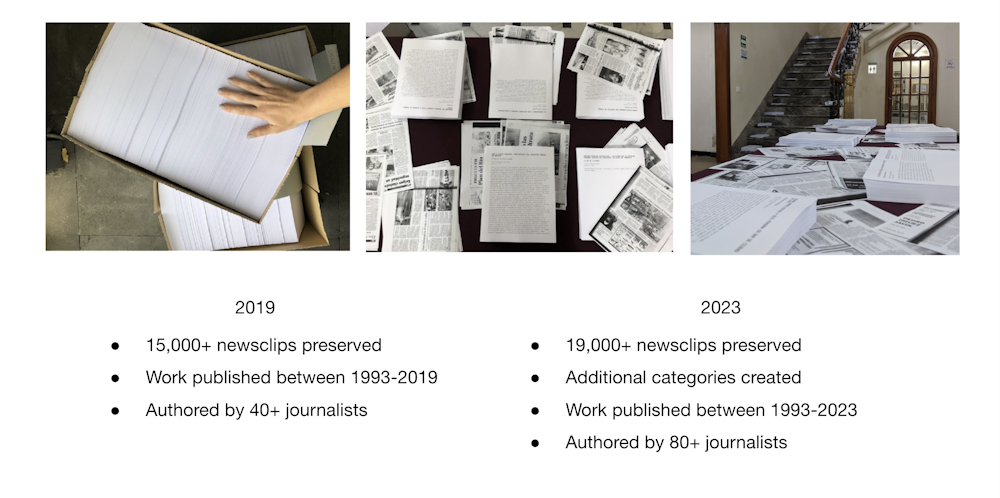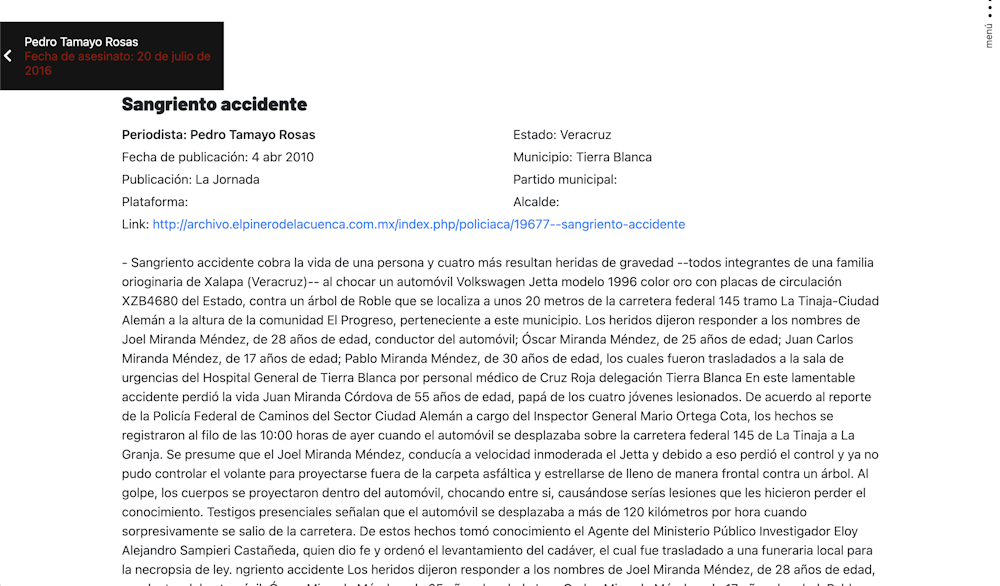In 2018, the archive began as a media innovation experimental project supported by a Magic Grant awarded to Alejandra Ibarra Chaoul by The Brown Institute for Media Innovation at Columbia University. Mexico is the deadliest country for reporters that is not at war, with more than 163 killed journalists since the year 2000. However, most people in Mexico have never read the work of killed reporters outside of their immediate communities, which contributes to the fact that killed reporters are not remembered for the work they produced defending democracy. Instead, their legacy often becomes the crime that took their lives.
During the first year of the Magic Grant, Alejandra was mainly dedicated to research and exploration. That is how she noticed the work produced by killed reporters in Mexico was hard to find. Most of the reporters who have been killed in Mexico were entrepreneurs and founders of their own media outlets. That also meant they published on blogspot or wordpress websites created by themselves and paid for by themselves too. When one of these reporters is killed, the payment for the domain of their website stops, deleting the entire content they produced. In other cases, reporters published on Facebook directly and some of their posts were flagged as sensitive after their passing, for which they were taken down. In most cases, the fact that reporters published on makeshift media outlets meant they also had other jobs simultaneously and, some reporters, published for several outlets. As soon as Alejandra realized this, she began reaching out to family members and colleagues of the deceased as well as researching on open sources about the lives and careers of killed reporters to establish timelines and pin down sources. Once she was able to identify the places where reporters had published and the time frames when they had, she began applying a diversity of methods to preserve the work. With a small team, she began digitizing what was preserved in the national archive of periodicals; she wrote tailored code for each specific website (which was later perfected by a member of the team) and scraped the content; she downloaded videos from Facebook and YouTube; and had acquaintances of the deceased share their loved ones work if it was kept at home. Throughout the second year working on the archive, Alejandra developed categories to catalogue each single publication, which would help conduct analysis further down the road. She also made sure to catalogue each entry with date of publication, name of news outlet, as well as geospatial data of the place where it was published. She then designed the main dataset to interact with two three more databases: one with information about each individual journalist (such as the age at time of death or information on the homicide investigation), information about the media outlet where they published (if it was corporate or of their own creation), and sociopolitical data on the municipality where the clips were published. By 2021, due to the interest of foundations, victims and researchers, Alejandra founded the Defensores de la Democracia (DDLD) nonprofit in order to continue the work, expand the archive and her team and guarantee the permanence of the archive. For the past two and a half years, the team has now specialized in the upkeeping of the archive and have been able to expand the archive from 14,000 entries to over 19,000. When the archive was first launched in 2019, DDLD had preserved the work of 43 reporters. Today, the archive holds the work of 83 journalists killed in Mexico. The archive has been reviewed by the American Journalism academic journal. It has been covered by news outlets in Mexico and abroad. The Reuters Institute wrote a review about it. And it received the Democratic Innovation Award by the Council of Europe in 2023.

DDLD is currently working on the upkeep of the archive as well as an expansion of the categories for analysis. We’re also developing an oral history repository based on interviews with the deceased acquaintances, which aims to add context, nuance and understanding to the work killed reporters produced and we have preserved. Once enough funding has been secured, a new version of our website will be published where both resources will be interconnected for public exporation.
The DDLD – living archive makes sure killed journalists’ contributions to the strengthening of democracy outlives them and continues to be public and available for remembrance and consultation.







































































































































Planning ahead for DVD-Video migration research
Starting with complexity: Archiving digital-born music compositions from Mac systems of the 80s/90s